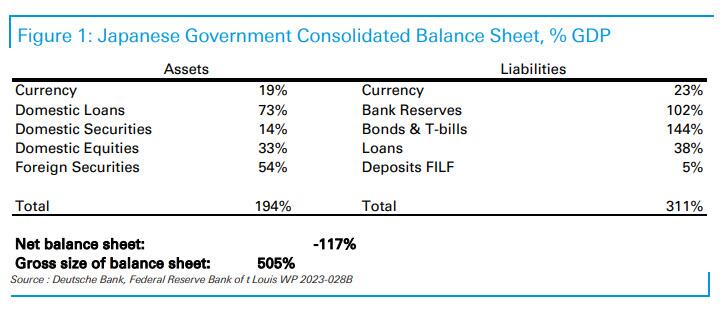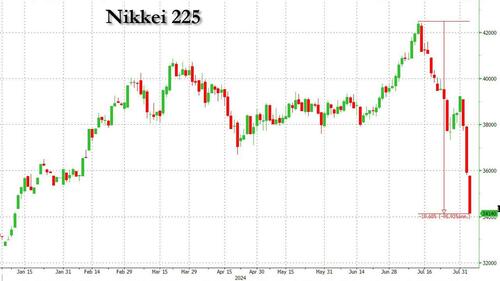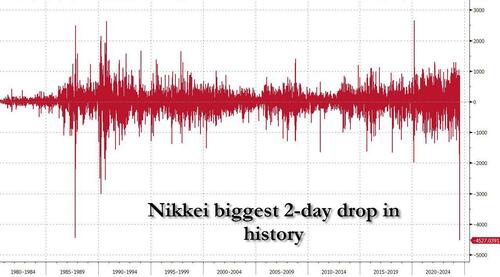The $20 Trillion Carry Trade Has Finally Blown Up
Late last year, when the latest cycle of the yen carry trade was still in its relative infancy (the USDJPY was in the low 140s then, on its way to a mindblowing and inflation-unleashing 162, not to mention two BOJ intervention), we explained why Japan's economy is now effectively dead, and the only thing missing was declaring the time of death. The reason: the $20 trillion carry trade that the government of Japan has been engaging in for the past 40 years has been one giant a ticking timebomb, one which can not be defused, and when it blows up, it's game over for the Bank of Japan.
去年底,当日元套利交易的最新周期仍处于相对初期阶段(当时美元兑日元在 140 低位,正朝着令人震惊且引发通胀的 162 迈进,更不用说两次日本央行干预),我们解释了为什么日本经济现在实际上已经死去,唯一缺少的就是宣布死亡时间。原因是:日本政府在过去 40 年中进行的 20 万亿美元的套利交易一直是一个巨大的定时炸弹,这个炸弹无法拆除,一旦爆炸,日本央行就完蛋了。
Why? well, with the help of DB's chief FX strategist George Saravelos we explained why last December when we also quantified the total size of the trade whose blow up will demand a coordinated central bank rescue in the coming days (not surprisingly the world's central bankers have no idea what has happened and will be panicking after the fact as usual, and unleashing a historic flood of rate cuts in the coming weeks to stabilize the situation).
为什么?好吧,在德意志银行首席外汇策略师乔治·萨拉维洛斯的帮助下,我们在去年十二月解释了原因,同时量化了这笔交易的总规模,这笔交易的崩溃将需要协调的中央银行救助(毫不奇怪,世界各国的中央银行家对发生的事情一无所知,通常在事后会感到恐慌,并在接下来的几周内释放出历史性的降息潮以稳定局势)。
For those who missed it back in December, here it is again, only this time the carry trade has burst, and either the BOJ will do nothing and watch as its economy implodes, or it will panic reverse the idiotic rate hike it did last week and triples down on easing to contain the crash that just pushed the Nikkei into a bear market; in either case, however, it is unfortunately game over for Japan.
对于那些在去年十二月错过的人,这里再次提及,只不过这次套利交易已经破裂,或者日本央行将无所作为,眼睁睁看着其经济崩溃,或者它将惊慌失措地逆转上周愚蠢的加息,并加大宽松力度以遏制刚刚将日经指数推入熊市的崩溃;然而,无论哪种情况,不幸的是,日本的游戏已经结束。
* * *
The government of Japan is engaged in one massive $20 trillion carry trade: here is the toxic dilemma faced by the Japanese central bank now that it has reached the end of the road: on one hand, if the Bank of Japan decides to tighten policy meaningfully, this trade will need to unwind. On the other, if the Bank of Japan drags its feet to keep the carry trade going, it will require higher and higher levels of financial repression but ultimately pose serious financial stability risks, including potentially a collapse in the yen.
日本政府正在进行一项巨大的 20 万亿美元的套利交易:日本中央银行现在面临的有毒困境是:一方面,如果日本银行决定有意义地收紧政策,这笔交易将需要解除。另一方面,如果日本银行拖延以维持套利交易,将需要越来越高的金融压制,但最终会带来严重的金融稳定风险,包括日元可能崩溃。
As Saravelos puts it, “Either option will have huge welfare and distributional consequences for the Japanese population: if the carry trade unwinds, wealthier and older households will pay the price of higher inflation via rising real rates; if the BoJ delays, younger and poorer households will pay the price via a decline in future real incomes.”
正如萨拉维洛斯所说:“无论哪种选择都会对日本人口产生巨大的福利和分配后果:如果套利交易解体,富裕和年长的家庭将通过上升的实际利率支付更高通胀的代价;如果日本央行延迟,年轻和贫困的家庭将通过未来实际收入的下降支付代价。”
Which way this political economy question gets resolved will be key to understanding the policy outlook in Japan in coming years. Not only will it determine the direction of JPY but also Japan’s new inflation equilibrium. Ultimately, however, someone will have to pay the cost of inflation “success.”
这个政治经济问题的解决方式将是理解未来几年日本政策前景的关键。这不仅将决定日元的方向,还将影响日本新的通胀均衡。然而,最终,还是会有人不得不为通胀“成功”付出代价。
The world's biggest carry trade
全球最大的套利交易
The starting point for the analysis are two excellent papers from the St Louis Fed and IMF, which consolidate the Japanese government’s balance sheet to include the central bank (BoJ), state-owned banks (namely, PostBank) and pension funds (namely, GPIF, the world's biggest pension fund). A consolidation of debt is crucial to understanding why Japan has not faced a debt crisis in recent decades given a public debt/GDP ratio of above 200% that continues to rise. It is also crucial to understanding what the impact of Bank of Japan tightening on the economy will be.
分析的起点是来自圣路易斯联邦储备银行和国际货币基金组织的两篇优秀论文,这些论文将日本政府的资产负债表整合,包括中央银行(日本银行)、国有银行(即邮政银行)和养老金基金(即全球最大的养老金基金 GPIF)。债务的整合对于理解为什么日本在最近几十年没有面临债务危机至关重要,尽管公共债务/GDP 比率超过 200%并持续上升。它对于理解日本银行收紧政策对经济的影响也至关重要。
So what does the government’s consolidated balance sheet look like? Below we show the results from the St Louis Fed paper. On the liability side, the Japanese government is primarily funded in low yielding Japanese Government Bonds (JGBs) and even lower-cost bank reserves. Over the last ten years the BoJ has effectively swapped out half of the entire JGB stock with even cheaper cash which it created, now held by banks. On the asset side, the Japanese government mostly owns loans, for example via the Fiscal and Investment Loan Fund (FILF), and foreign assets, primarily via Japan’s largest pension fund (the GPIF). The Japanese government's net debt position of 120% of GDP when accounting for all of this is one reason why debt dynamics have not been as poor as what would seem at first sight.
那么政府的合并资产负债表是什么样的呢?下面我们展示了圣路易斯联邦储备银行论文的结果。在负债方面,日本政府主要通过低收益的日本国债(JGBs)和成本更低的银行准备金进行融资。在过去十年中,日本银行有效地用其创造的更便宜的现金置换了整个 JGB 存量的一半,这些现金现在由银行持有。在资产方面,日本政府主要拥有贷款,例如通过财政和投资贷款基金(FILF)以及外汇资产,主要通过日本最大的养老金基金(GPIF)。在考虑所有这些因素后,日本政府的净债务占 GDP 的 120%是债务动态没有像乍一看那样糟糕的原因之一。
But what is even more important is the asset-liability mix of this debt. As Saravelos explains, at a gross balance sheet value of around 500% GDP or $20 trillion, the Japanese government's balance sheet is, simply put, one giant carry trade. It goes at the crux of why it has been able to sustain ever-growing levels of nominal debt.
但更重要的是这笔债务的资产负债结构。正如萨拉维洛斯所解释的,以大约 500% GDP 或 20 万亿美元的总资产负债表价值来看,日本政府的资产负债表,简单来说,就是一个巨大的套利交易。这正是它能够维持不断增长的名义债务水平的关键所在。
As the authors of the SF paper argue, the government is funding itself at very low real rates imposed by the BoJ on domestic depositors, while earning higher returns on foreign and domestic assets of much higher duration. As that return gap has been expanding, this has created extra fiscal space for the Japanese government. Crucially, one third of this funding is now effectively in overnight cash: if the central bank raises rates the government will have to start paying money to all the banks and the carry trade’s profitability will quickly start unwinding.
正如 SF 论文的作者所言,政府以日本银行对国内存款人施加的非常低的实际利率为自己融资,同时在期限更长的外国和国内资产上获得更高的回报。随着这一回报差距的扩大,这为日本政府创造了额外的财政空间。至关重要的是,这笔资金的三分之一现在实际上是隔夜现金:如果中央银行提高利率,政府将不得不开始向所有银行支付资金,套利交易的盈利能力将迅速开始回落。
Why hasn’t the carry trade blown up?
为什么套利交易没有崩溃?
The first question that then arises is why hasn’t this carry trade blown up over the last few years given the huge sell-off in global fixed income? Everyone else has stopped out of carry trades, why hasn’t Japan? The answer is simple: on the liability side the BoJ controls the government's cost of funding and this has been kept at zero (or indeed negative) despite rising inflation. On the asset side, the Japanese government has benefited from a massive depreciation in the yen which has raised the value of its foreign assets. Nowhere is this more evident than the GPIF, which has delivered cumulative returns in the last few years larger than the past two decades combined. The Japanese government has earned returns from both the FX and fixed income legs of the carry trade. It is not only the Japanese government that has benefited, however. Falling real rates benefit every asset owner in Japan, predominantly older wealthy households. It is often claimed that an ageing population does well from low inflation. In fact, in Japan it is quite the opposite: older households have proven bigger beneficiaries of rising inflation via the de facto decrease in real rates and increase in value of the assets they own.
第一个问题是,考虑到全球固定收益市场的巨大抛售,为什么在过去几年中这种套利交易没有崩溃?其他人都已经停止了套利交易,为什么日本没有?答案很简单:在负债方面,日本央行控制着政府的融资成本,这一成本尽管通胀上升,仍然保持在零(甚至是负值)。在资产方面,日本政府受益于日元的大幅贬值,这提高了其外汇资产的价值。没有哪个地方比日本政府养老金投资基金(GPIF)更明显,该基金在过去几年中实现的累计回报超过了过去二十年的总和。日本政府从套利交易的外汇和固定收益两个方面都获得了回报。然而,受益的并不仅仅是日本政府。实际利率的下降使日本的每个资产拥有者受益,主要是年长的富裕家庭。人们常常声称,老龄化人口在低通胀环境中表现良好。 事实上,在日本情况恰恰相反:年长家庭通过实际利率的下降和他们所拥有资产价值的增加,成为通货膨胀上升的更大受益者。
The moment of reckoning 审判时刻
What will force this carry trade to unwind ? The simple answer is sustained inflation. Consider what would happen if inflation required the Bank of Japan to hike rates: the liability side of the government balance sheet will take a huge hit via higher interest payments on bank reserves and a decline in the value of JGBs. The asset side will suffer via a rise in real rates and an appreciation of the yen that causes losses on net foreign assets and potentially domestic assets too. The wealthy, older households will take a similar hit too: their asset values will drop while the fiscal capacity of the government to fund pension entitlements will erode. On the flipside, the younger households will be better off. Not only would they earn more on their deposits, the real rate of return on their future stream of savings would rise too.
是什么将迫使这种套利交易解消?简单的答案是持续的通货膨胀。考虑一下如果通货膨胀迫使日本银行加息会发生什么:政府资产负债表的负债方将因银行准备金的利息支付增加和日本国债(JGB)价值下降而受到巨大打击。资产方将因实际利率上升和日元升值而遭受损失,这将导致净外资产和潜在的国内资产也出现损失。富裕的老年家庭也将受到类似的打击:他们的资产价值将下降,而政府资助养老金权益的财政能力将减弱。另一方面,年轻家庭的情况会更好。他们不仅会在存款上赚得更多,未来储蓄流的实际回报率也会提高。
Are there ways for the government to prevent the pain and required fiscal consolidation that higher inflation would create, especially on older households? There are really just three options, and neither is satisfactory.
政府是否有办法防止更高通胀所带来的痛苦和所需的财政整合,特别是对老年家庭?实际上只有三种选择,但都不令人满意。
- Tax younger households. Rather than reducing pension outlays to help improve the fiscal balance, another alternative is to increase taxation too. The key constraint here would be a political one because older households are wealthier and have already been the primary beneficiaries of the Bank of Japan's QQE policy.
对年轻家庭征税。与其减少养老金支出以帮助改善财政平衡,另一种选择是增加税收。这里的关键限制将是政治因素,因为老年家庭更富裕,并且已经是日本银行量化宽松政策的主要受益者。 - Prevent real rates from rising. In practice, this would mean that the Bank of Japan tolerates persistently higher inflation by staying behind the curve and eroding the real value of government debt. This is ultimately a variation of fiscal dominance which at its extreme would pose serious financial stability risks. If domestic households reach the conclusion that the yen’s monetary anchor is lost, we would ultimately see capital flight and a dramatic depreciation in the yen (this is the most likely outcome).
防止实际利率上升。实际上,这意味着日本银行容忍持续较高的通货膨胀,滞后于经济形势,从而侵蚀政府债务的实际价值。这最终是一种财政主导的变体,极端情况下会带来严重的金融稳定风险。如果国内家庭得出结论认为日元的货币锚已经丧失,我们最终将看到资本外流和日元的剧烈贬值(这是最可能的结果)。 - Don’t pay the banks. The single biggest funder of the Japanese government’s carry trade is the banking system via its large holdings of excess reserves. There is then one straightforward way of preventing the central bank (and by extension) the government’s interest bill from rising: apply reverse tiering to excess reserve balances by not paying interest. This is an approach that is already followed by Switzerland and may well work in the short-term. Ultimately, however, it creates serious financial stability risks because it prevents banks from passing on the full benefit of interest rate increases to depositors. The end result would be to create conditions for deposit flight similar to what we saw in the US regional banks crisis this year.
不要支付给银行。日本政府的套利交易最大的资金来源是银行系统,通过其大量的超额准备金持有。为了防止中央银行(以及政府)的利息支出上升,有一种简单的方法:对超额准备金余额应用反向分层,不支付利息。这是瑞士已经采取的一种做法,并可能在短期内有效。然而,最终,这会造成严重的金融稳定风险,因为它阻止银行将利率上升的全部好处传递给存款人。最终结果将是创造类似于我们在今年美国地区银行危机中看到的存款外流的条件。
Of course, none of the options discussed above are sustainable over the long-term. However, they help highlight a menu of policy choices that can be deployed to delay or attenuate the distributional trade-offs that a higher inflation regime in Japan creates (all of them would lead to tremendous social upheaval, and political instability as the period of can kicking is now over).
当然,上述讨论的选项在长期内都不可持续。然而,它们有助于突出一系列政策选择,这些选择可以用来延迟或减轻日本高通胀体制所带来的分配权衡(所有这些都将导致巨大的社会动荡和政治不稳定,因为踢罐子的时期已经结束)。
Conclusion 结论
The last few years of extremely easy monetary policy have been relatively straightforward from a Japanese political economy perspective: falling real rates, improving fiscal space and income redistribution that has favored wealthy, older voters. If Japan is indeed embarking on a new chapter of structurally higher inflation, however, the choices going forward are going to be far less easy. Adjusting to a higher inflation equilibrium will require rising real rates and greater fiscal consolidation, in turn more damaging to older and wealthier voters, unless the younger voters get taxed. While this adjustment can be delayed, it would be at the cost of even greater financial instability down the road, and a much weaker yen. The yen, in turn, can only embark on a sustained uptrend when the Japanese government – via BoJ rate hikes – is forced to unwind the world's last big surviving carry trade in the post-COVID world, one which has allowed Japan to enjoy a period of eerie social and political calm. Those days, however, are about to come to a thunderous end.
过去几年极其宽松的货币政策从日本政治经济的角度来看相对简单:实际利率下降,财政空间改善,收入再分配有利于富裕的老年选民。然而,如果日本确实开始进入一个结构性更高通胀的新篇章,未来的选择将会变得更加困难。适应更高的通胀均衡将需要提高实际利率和更大的财政整合,这反过来对老年和富裕选民造成更大的损害,除非年轻选民被征税。虽然这种调整可以被推迟,但代价将是未来更大的金融不稳定和更弱的日元。日元只有在日本政府通过日本银行加息被迫解除后疫情世界中最后一个大型生存套利交易时,才能开始持续的上升趋势,这使得日本享受了一段令人不安的社会和政治平静。然而,那些日子即将以雷鸣般的方式结束。
Full DB note available to pro subs in the usual place.


